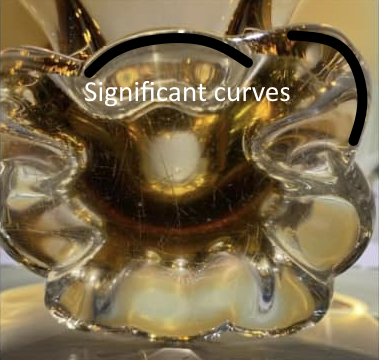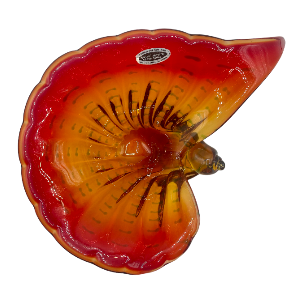
Let’s explore one of Canada's most elusive vintage glasshouses, we will uncover the history of Mosaic Artistic Glass Limited, known simply as Mosaic. Nestled in the heart of Cornwall, Ontario, Mosaic opened its doors on June 5, 1969. Despite its compact footprint of 8,400 square feet, the factory was a hive of creativity, attracting skilled glassblowers from the shores of Italy, Venice, and Spain, making it a melting pot of glassblowing traditions. For a deeper insight into the operational timelines and transformations of Canadian vintage glasshouses, an in-depth article is available here.
The curtain fell on Mosaic's operations under a veil of speculation, with no concrete records pinpointing the exact date of closure. It's believed that the factory's flames flickered for a brief year before dimming. A significant clue to its fate lies in the property sale records, marking the factory up for sale on April 2, 1971, leaving us to ponder if financial woes sealed its fate before this date.
In the world of Canadian vintage art glass, Mosaic pieces are like rare gems, their scarcity a testament to the brief window of production. Their rarity eclipses that of contemporaries like EDAG, Chalet, and Lorraine, not merely by the numbers but by the distinctiveness of their creations. Mosaic broke the mould, daring to diverge from the prevalent Canadian glass aesthetic with its innovative shapes and vibrant palette.
As we peel back the layers of Mosaic's legacy, we invite you to join us in a tactile journey through its glass artistry. We'll navigate the spectrum of colours, the diversity of bases, and the symphony of forms that define Mosaic's collection. Through this exploration, we not only celebrate the artistry of Mosaic but also contribute to preserving the narrative of a fleeting yet impactful chapter in Canada's glassblowing heritage. Let's immerse ourselves in the beauty of Mosaic's creations, each piece a silent storyteller of a vibrant, albeit brief, era in Canadian craftsmanship.
Canadian Vintage Art Glass: Mosaic Glass Colour-ways
Diving into the vibrant world of Mosaic's colour-ways, we uncover a hallmark of their craftsmanship: the captivating technique of colour ribbing. This distinctive feature adorns many Mosaic creations, serving as a beacon for identifying their unique glass art. Employed commonly by this glasshouse, the ribbing, a visual symphony of applied colourful lines, placed on the contours of each piece where the glass swells and curves outward. The ribbing palette is known to embrace hues of blue, green, dark blue, orange and red, adding a dynamic layer to an array of shapes including, but not limited to, stretches, bowls, and vases. Here, we explore the kaleidoscope of colour combinations that Mosaic masterfully intertwined:
Purple-over-amber with green ribbing,
Olive-over-blue with red or orange ribbing,
Red-over-amber with green ribbing,
Red-over-amber with blue ribbing
Orange-over-amber with blue ribbing,
Green-over-amber with red ribbing
Green-over-amber with dark blue ribbing
Green-over-blue with red ribbing
Blue-over-green with red ribbing
While the ribbed pieces are a testament to Mosaic's innovative spirit, the glasshouse also ventured into the realm of simplicity with creations devoid of ribbing. These pieces, either in harmonious two-tone or in serene monochromatic hues, showcase the versatility and breadth of Mosaic's palette. Among these, we find the earthy interplay of red-over-amber, the subtle elegance of olive meeting amber, and the bold statement of solid red.
Canadian Vintage Art Glass: Mosaic Glass Designs Elements
In the realm of Mosaic Glass Designs, a defining feature on many Mosaic pieces is the presence of "ribs" - distinct lined glass protrusions formed by molding techniques. These ribs, often found in configurations of 8, 12, or 16, serve as the canvas for Mosaic's signature colored ribbing, setting these pieces apart with a recognizable and attributable aesthetic. While this ribbed design is a hallmark of Mosaic, the glasshouse also crafted pieces without ribbing, bearing a closer resemblance to other Canadian vintage art glass pieces, in this case these pieces can be identified by observing the base of the piece.
Another technique observed in Mosaic glass creations goes by the name of Zebrati, an Italian/Murano glass technique which creates stripes similar to those on a zebra. This technique can be seen on the piece below, where the blue lines circle the pieces creating a striped effect.
Canadian Vintage Art Glass: Mosaic Glass Bases
Mosaic glass creations are distinguished by a select few identifiable bases, each adding to the allure of their design. The primary base style is directly influenced by the characteristic ribbing found on many Mosaic pieces. This design results in bases with lobes, each mirroring the glass ribs above, creating a harmonious visual flow from the body of the piece down to its foundation. For Mosaic there were three variations if this base each dependent in the number of lobes, they are as follows; one with 8 lobes, one with 12 lobes and lastly one with 16 lobes (see photos below). Lorraine had also produced a similar base however the ribbing in these pieces, has a differing number of lobes and does not extend the entire body of the pieces and most definitely has not been seen with colour ribbing.
In addition to this rib-influenced base, a secondary style has been observed on pieces that retain their original stickers. This design features a square base, each corner accentuated by a lobed piece of glass. This square base design stands in contrast to similar creations by Lorraine, which tend to be more rounded. The Mosaic base has sharper lines and a less globular appearance.
Canadian Vintage Art Glass: Mosaic Glass Forms
The forms of Mosaic glass pieces discovered thus far are familiar in shape to the other Canadian vintage art glass houses, yet they carry distinctive "under the sea" design motifs, adding a layer of intrigue and uniqueness to each creation. The collection includes stretches or gondolas, notable for their added "points" - a feature that might be new to some but can be learned by clicking here. These points, often found on 8-point stretches, range from prominent side pulls to subtler accents achieved through shallow scissoring. In particular, some gondola designs mimic marine life, with one version featuring three pulls on each side, evoking the stinger and back fins of a stingray, while another resembles two angelfish positioned back-to-back.
Continuing the marine theme, Mosaic also ventured into shell-shaped designs. These Mosaic shells are notably substantial, with dimensions averaging 14.5 inches in length, 10 inches in width, and 4.5 inches in height. Their design takes inspiration from the spiraling form of a nautilus shell, starting with a tight coil and gracefully unfurling to its outermost edge.
Mosaic explored variations of bowls embellished with points, echoing the forms of sea anemones or the vividly patterned blue-ringed octopus native to Australian waters. These pieces, often featuring 8 points, serve as a testament to Mosaic's talent for infusing standard forms with imaginative details. They also made their own variation of a 4-point twist found in red-over-amber and sitting on the Mosaic square base. The twists on this piece are less exaggerated compared to the twist founds on EDAG or Lorraine pieces of a similar form which you can check out by clicking here. They also created a more regular bowl shape as imagined below in purple-over-amber with green ribbing and orange-over-amber with blue ribbing.
In addition to its array of unique glass pieces, Mosaic introduced its own version of the fazzoletto, or handkerchief vase, which stands out for its robust pulls. This particular design has been spotted in a striking red-over-amber color scheme, accentuated with blue ribbing, adding a vibrant touch to its appearance. The process used to create this vase involved not just the traditional swinging technique but also a subsequent shaping phase, where the glass was manually pulled to achieve its final form. This method left behind distinctive tooling marks on the pulls, offering a glimpse into the hands-on process used to make these pieces. Mosaic also made a more common vase form which has been seen in a striking red with green ribbing and this piece has the presence of uranium oxide.
After the initial publication of this article, another Mosaic vase has surfaced. This one stands out due to its unique shape and color combination. It's the first documented vase with a blue-over-green color scheme and features red ribbing. The green hue is incredibly bright, almost suggesting it might contain uranium oxide, but it does not glow under UV light. Additionally, the vase has a distinctive top cover with a hole in it. The 12-point base indicating that the 12-point mold was used to create this piece.
In addition to its stunning vibrant colors and shape, this vase has a hidden "wow" factor. When looking straight down into the vase, it creates an effect that is absolutely all-consuming, resembling a kaleidoscope.

Finally, Mosaic's interpretation of the 'splash' form - a staple in Canadian vintage art glass, characterized by its resemblance to water splashing upwards - incorporates the signature ribbing pattern, making these pieces instantly recognizable. Characterized by 8 dynamic pulls emanating from the ribs. The Mosaic splash stands out even more for its elongated pulls, which culminate in distinctly thickened tips, further emphasizing the piece's visual impact.
Entering the Zoo: Mosaic Artistic Art Glass Animals
As we’ve been exploring the many dramatic shapes resembling sea creatures, I’d like to shift our focus to the zoo, featuring ‘Smiles,’ the double-labelled camel. Moving from sea to land, Mosaic Artistic Glass’ creativity shines again. This particular animal form is uncommon in Canadian vintage art glass. With its charming green and amber colourway, cartoonish bulbous nose, and delightful smile, ‘Smiles’ is sure to enhance any display. Sculpted entirely from a single piece of glass, the camel features rounded pulls for ears and more pointed pulls for its two humps. Standing on four distinct legs, it measures 8.5” long and 7” tall.
Final Tide: Echoes of Canadian Vintage Art Glass in Mosaic's Sea
Exploring the legacy of Mosaic Artistic Glass Limited reveals a rich narrative of creativity and distinctive design within the Canadian vintage art glass scene. Mosaic's unique approach to ribbing, color combinations, and base designs set its pieces apart, making them a rare find in today's collector's market. The forms crafted by Mosaic, from the sea-inspired stretches and gondolas to the large, nautilus-like shells, showcase the glasshouse's imaginative motifs.
Despite its short operational period, Mosaic left a lasting impression on Canadian vintage art glass, introducing pieces that continue to captivate collectors and enthusiasts with their beauty and originality. The scarcity of Mosaic pieces only enhances their allure, turning the search for these rare items into a rewarding endeavor for those who appreciate the artistry of Canadian glass.
In preserving the memory and celebrating the artistic achievements of Mosaic, we honor a unique chapter in Canada's artistic heritage. This not only enriches our understanding of the country's cultural history but also inspires a continued appreciation for the craftsmanship and innovation that define this fleeting yet impactful period in Canadian glassmaking.
Some of the photographs in this article were contributed by Daniel M. Lynch. The rights to publish these photographs have been duly obtained and purchased.





















































































































































